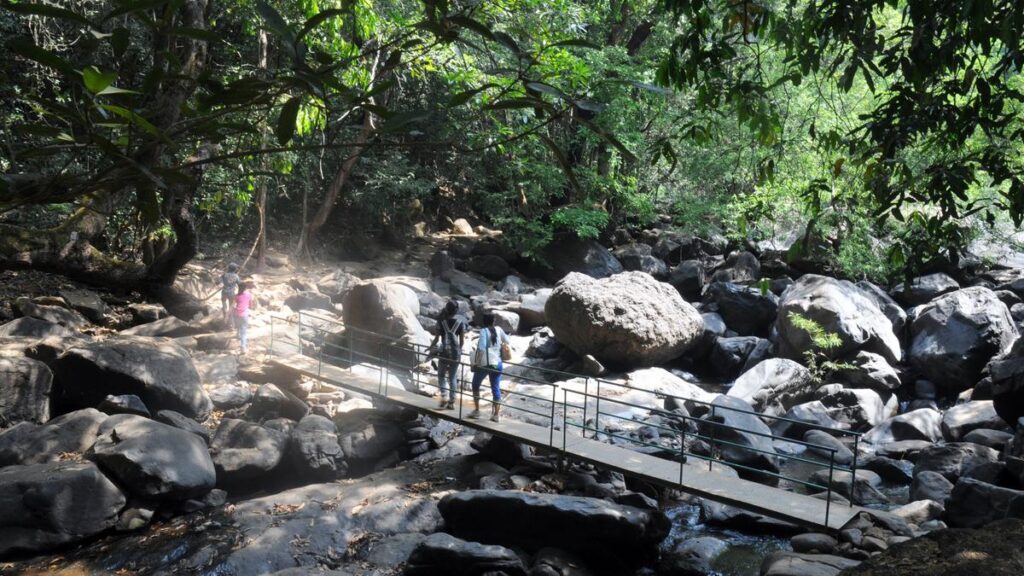
Bhagwan Mahavir Wildlife Sanctuary, the biggest of the three sanctuaries in Goa.
| Photo Credit: Paul Noronha
Goa is often seen as a prime tourist destination rather than an ecological hotspot. A study, ‘Insights into the linkages of forest structure dynamics with ecosystem services’, published on May 4 in the journal Nature, however, evaluated the extent and condition of forest ecosystems in Goa in the central Western Ghats, a biodiversity hotspot.
Prioritisation of Ecologically Sensitive Regions (ESR) revealed that 54.41% of the region is highly sensitive. Land use dynamics revealed that the total forest cover declined by 3.75% during the post-1990s due to market forces associated with globalisation, along with a decline in evergreen forest cover of 10.98%, said the study.
Land cover changes
The authors of the study, T. V. Ramachandra, Paras Negi, Tulika Mondal and Syed Ashfaq Ahmed, from the Indian Institute of Science, Bengaluru, and Kuvempu University, Shivamogga, explain how large-scale land cover changes leading to land degradation and deforestation in fragile ecosystems such as the Western Ghats have impaired ecosystem services, evident from the conversion of perennial water bodies to seasonal. This, they say, necessitates an understanding of forest structure dynamics with ecosystem services to evolve appropriate location-specific mitigation measures to arrest land degradation.
“India has been experiencing desertification in most States and Union territories, and about 97.85 million hectares (29.77%) were impacted by land degradation due to the loss of vegetation cover and subsequent topsoil erosion accounting for 11.01% of degradation in the country in 2018-19, majorly contributed by Rajasthan, Maharashtra, Gujarat, Jammu & Kashmir, Karnataka, Jharkhand, Odisha, Madhya Pradesh, and Telangana States. The most significant process of desertification or land degradation in Goa is evident from escalating (37.32% in 2011-13 and 35.74% in 2003-05) degradation,” said the study.
The central Western Ghats landscape, spanning Karnataka, Goa, and Maharashtra States, is endowed with exceptional ecological significance, evident from rich biodiversity, perennial rivers, myristica swamps, prominent geological features, captivating beauty, rich cultural heritage locations (sacred groves), said the study, adding that Goa hosts a diverse array of species across various habitats, including forests, coastal areas, and marine ecosystems.
Endemic plants
Notably, Goa harbours about 7% of the endemic flowering plant species found in the Western Ghats. The region is home to over 3,000 species of plants and flowering trees, including several IUCN Red-listed species, says the study.
Apart from land use, the study reveals that open spaces in Goa experienced a substantial reduction from 711.19 sq. km (19.21%) in 1973 to 207.1 sq. km (5.59%) in 2022 due to urban expansions with the consistent growth in built-up areas from 22.2 sq. km (0.6%) in 1973 to 180.94 sq. km (4.89%) in 2022.
“Unplanned developmental activities have contributed to rapid urbanisation leading to sprawl with the expansion of major cities such as Panaji, Mormugao, Ponda, and Mapusa, and industrial areas like Verna, which has profound impacts with fragmentation of ecosystems, resulting in biodiversity losses and erosion of essential ecosystem functions,” said the study, adding that this leads to significant declines in species richness and genetic diversity, with smaller and more isolated forest fragments experiencing the greatest biodiversity loss due to reduced habitat size and increased isolation.
Agricultural landscape
The agricultural landscape too has expanded, the study said.
“Forest ecosystems in Goa have witnessed change and degradation since their value is poorly understood, and not considered in the policy-making process,” said the study, offering the examples of a significant decline in agricultural productivity in many Goan villages due to environmental degradation and lowered fertility of the khazan wetlands.
“Goa is trying to accelerate economic growth, and there has been tremendous pressure to divert natural systems to other uses. Hence, there is an urgent need to undertake the natural capital accounting and valuation of the ecosystem services, especially intangible benefits provided by ecosystems,” said the authors.
Published – May 06, 2025 10:57 am IST

